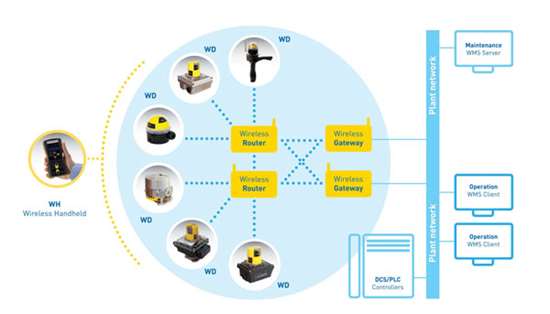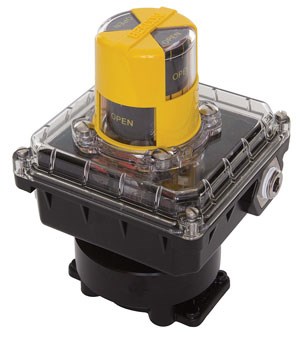Wireless Solutions Keep Close Watch on Valves
The number of valves and valve types that go into modern process plants today to precisely control operations is huge.
#controls
The need to monitor valves within modern process plants is greater than ever. A malfunctioning valve or one that is incorrectly left open, closed or partially open can result in health and safety risks, affect plant performance and lead to environmental damage. In some of today’s industries, there are also regulations that may require constant recording of valve positions. Plant operators strive to monitor the greatest number of valves possible both to increase efficiency and keep personnel and the environment safe. By continuously monitoring a valve, these operators benefit from enhanced production control, reduction of errors in the process and improved safety of the process line.
The weight of each of these benefits depends on the industry. For example, of all the major incidents and accidents in the refining and petrochemical industry, about 30% result in injury or loss of life, while over 60% lead to regulatory fines and production downtime.1 These incidents not only have an impact on the safety of the people at the plant, they can result in substantial costs through reduced efficiency and downtime. While the dangers and cost may not be a direct result of insufficient valve monitoring, understanding the status of each critical valve, especially if it can be achieved in real time, can greatly reduce the risk of an incident.
CONSEQUENCES OF UNMONITORED VALVES
In a major study, about half of valve incidents resulting in leakage were attributed to “operational issues” (not valve defects or malfunctioning). Almost 30% of these operational issues were the direct result of a valve simply being left open or wrongly opened without notice.2
Most plant operators deal with these situations every year. Since the majority of valves are unmonitored, events can go undetected for long periods of time, depending on the maintenance schedule. This can cause significant operational losses in addition to environmental and safety risks.
TRADITIONAL MONITORING
The complexity of modern processes means it is increasingly difficult to monitor all valves at all times. Some plants have turned to traditional automated monitoring systems that rely on a wired network. But as the number of valves that need monitoring increases, so does the burden put on the system, which means more need for wires, cable trays, cabinets and input/output devices. In projects with severe space constraints, such as offshore platforms, housing additional hardware becomes a challenge. In applications where air conditioning, heat or extreme temperature control for hazardous chemicals or nuclear radiation is required, the need to find room for more hardware for monitoring becomes even more challenging.
Also, because of the complexity and large number of required parts, wired systems can cost between $2,000 and $5,000 per valve for installation. In harsh environmental conditions, failures can result because of wires exposed to those conditions. Maintenance costs add to the initial outlay installation costs because wires can wear and break, connections can become loose, and repairs must be carried out by trained personnel.
WIRELESS VALVE MONITORING
To overcome the challenge of monitoring all valves within a plant, a number of manufacturers have developed wireless valve monitoring systems. A wireless network can make it possible to monitor all types of valves in the facility and deliver comprehensive data relating to valve performance and status in real-time.
These wireless valve monitoring systems use radio signals and a networked system of field monitoring devices. The technology is integrated with distributed control systems, programmable logic controllers and supervisory control and data acquisition systems to provide real-time information on valve status as well as flow, temperature and density conditions through wireless transmitters. The network comprises a wireless device at the valve, a wireless router and gateway connected to the plant’s network maintenance and operations functions. Integration with the plant network is facilitated with open protocols such as open process control, Modbus remote terminal unit/transmission control protocol and Profibus. To add to effectiveness, there usually are a variety of options available such as multiple housing configurations, high visibility beacons, intrinsically safe and explosion-proof options, and direct mounts to valves and actuators.
HOW IT’S DONE
Typically, a valve monitoring wireless device is mounted to a valve and reports that valve’s position at regular intervals, such as every 15 minutes or following every valve movement of at least 1.5 degrees. This enables creation of valve signatures for automated valves. The device also monitors temperature, battery status and alarms, and messages are transmitted with a real-time stamp. It is then possible to detect whether a valve opens too quickly or slowly, as well as monitoring patterns over time because the diagnostic data is embedded in the valve signature. Maintenance can be planned, and incidents can be investigated immediately.
Reliable wireless valve monitoring systems also should be designed for low power consumption and immunity from background interference. This allows reliable readings and long battery life for the wireless units. Field devices also should be configured using a mesh network topology to ensure full redundancy and to avoid any single point of failure, thereby ensuring the highest level of effective valve monitoring at all times.
In most circumstances, a simple configuration through routers can be done so that 100 valves can be installed per gateway. Plant operators can then add 10,000 valves through up to 100 wireless gateways that can be connected per server. Without routers, about 30 valves per gateway can be connected.
Handheld devices allow local communication with the key components of the system, including the wireless device, the router and the gateway. Intended for use at close range, wireless handheld devices are used to calibrate and set up each wireless device, configure operator identification and passwords, turn units on and off, and prompt transmission confirming a valve’s status. This makes troubleshooting in the field efficient. By allowing plant operators to operate the system locally and remotely, the signal level can be measured with control and flexibility.
ADVANTAGES OF WIRELESS
Wireless valve monitoring systems offer many advantages including costs 25–60% lower than conventional wired systems. This is because of lower cost of installation (the wires and routing), which usually accounts for about half the monitoring cost. Reduced installation cost can also mean a greater number of valves can be monitored for the same capital investment. In most cases, wireless technology can triple monitoring instrumentation in a typical process plant, which can improve plant safety and efficiency.
Wireless monitoring systems are easier to engineer and install than wired, thanks to the simplicity of the design and the need for fewer parts. This also allows rapid commissioning, calibration and startup through the handheld devices, and requires a smaller footprint, providing a good solution for areas with space constraints. Fewer visits to hazardous areas are required, and the number of unwarranted inspections is lowered, saving labor costs.
Without monitoring, the efficiency of an automated valve is difficult to assess. Wireless valve monitoring provides accurate, up-to-date information on the valve’s status at any point in time and will deliver the valve’s operational signature, enabling cost-effective predictive maintenance. Wireless monitoring systems also have multiple paths of communication; if a device fails or a path is blocked, the system finds another route to ensure that data from the valve reaches the control system.
LIMITATIONS OF WIRELESS
A variety of factors can limit the performance of wireless valve monitoring systems. These include the distance between the wireless router and each valve’s monitoring device and the topology of the plant. If large obstructions are present, they can block communications, either reducing the efficiency of the monitoring or rendering it impossible.
In addition, rain, ice and snow can increase transmission error rates, though there are exceptions depending on how the system is set up. For example, in a mesh environment, a secondary path would be used should the primary path fail.
Performance also can be reduced in hazardous or corrosive environments.
In addition, some wireless systems may not meet full industry standards. Plant operators must ensure that the system they specify is from a reputable supplier, and that it complies with ISA-100.11a Wireless Network Optimized for Industrial Monitoring.
As with all aspects of a well-run plant, its operators should carefully consider the most appropriate technology for each application to overcome challenges and achieve the most effective monitoring system for their needs.
CONCLUSION
Because of the increased complexity of modern process plants and the desire to monitor more valves than ever before, it is clear new solutions are needed to complement traditional methods of valve monitoring. Over the years, reduced manpower, increased legislation and continuing efforts to drive down costs have made valve monitoring systems indispensable. Wireless technology offers a means to monitor more valves than ever before in real time and in many types of conditions.
Mike Lutolf is global product manager, controls, Westlock Controls. Westlock is a division of Pentair Valves & Controls.
1 Reducing Major Accident Potential: Lessons from the Refining Industry, DNV Energy
2 Assessment of valve failures in the offshore oil and gas sector. National Engineering Laboratory, on behalf of the Offshore Division of Health & Safety Executive. UK Offshore Oil & Gas Industry
RELATED CONTENT
-
The Basics of Eccentric Plug Valves
Wastewater systems present many challenges to pumps and valves because the flow can contain grit, solids and debris, depending where in the process the equipment is located.
-
The Diverse Role Valves Play in the Chemical Industry
The chemical industry is extremely diverse with more than 60,000 known products. Like all process industries, the chemical industry needs valves designed for safe, efficient and reliable process operation.
-
Paint & Coatings
A walk through a typical valve distributor’s warehouse will yield a contrasting view of either silver or black products.












 Unloading large gate valve.jpg;maxWidth=214)